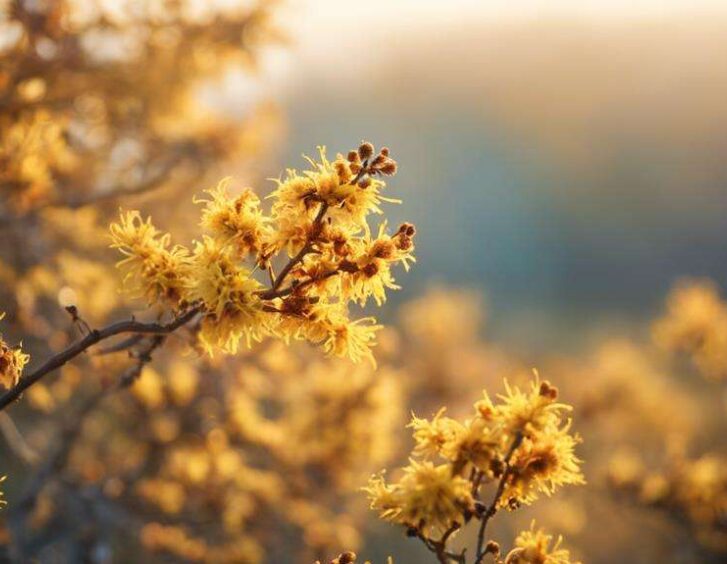With a range of over 10 captivating witch hazel varieties available, you can transform your outdoor space into a vibrant haven filled with an array of colorful blooms, unique textures, and delightful scents.
Each type, from the elegant 'Amethyst' to the classic 'Common Witch Hazel', brings its own charm and beauty to your landscape.
To ensure your witch hazel thrives, it's essential to prune it regularly, maintain consistent soil moisture, and apply fertilizer in the early spring months. These simple steps will reward you with a year-round spectacle of natural beauty and a thriving garden ecosystem.
Delve into the enchanting world of witch hazel, where you'll uncover the keys to creating a truly breathtaking outdoor sanctuary.
Key Takeaways
• Witch hazels offer year-round beauty, transforming landscapes with a kaleidoscope of colors, textures, and fragrances.
• With over 10 unique varieties, choose from a range of characteristics, such as 'Amethyst' or 'Harvest Moon', to suit your landscape design.
• Regular pruning, consistent moisture, and balanced fertilization ensure healthy growth and optimal performance.
• Witch hazels thrive in rich, moist, acidic soil, making them ideal for water conservation efforts and pollinator-friendly habitats.
• Plant witch hazels in hedgerows, woodland gardens, or full-sun shrub borders to add structure, texture, and seasonal interest.
Witch Hazel Varieties Galore
With over 10 unique varieties to choose from, including 'Amethyst', 'Arnold Promise', and 'Common Witch Hazel', you're spoiled for choice when it comes to selecting the perfect witch hazel for your landscape. Each cultivar boasts its own distinct characteristics, ensuring you'll find one that fits your unique landscape design.
For instance, 'Diane' offers vibrant, orange-yellow flowers, while 'Harvest Moon' features bright yellow blooms. Consider 'Lombarts Weeping' for a beautiful, weeping habit or 'Pallida' for its fragrant, yellow flowers. With such a diverse range of unique cultivars, you're sure to find the ideal witch hazel to enhance your outdoor space.
Growing Tips and Tricks
Regular pruning of your witch hazel is crucial to prevent root suckers from taking over your garden, as these shrubs can spread quickly if left unchecked. By doing so, you'll maintain a healthy and controlled growth habit.
When it comes to watering, providing consistent moisture is vital, especially during the first year after planting. Watering techniques like mulching around the base and avoiding overhead sprinklers can help retain moisture and prevent disease.
A regular fertilizing schedule will also promote vibrant growth. Feed your witch hazel with a balanced fertilizer in early spring, following the manufacturer's instructions.
Year-Round Beauty Unleashed
Reveal vibrant witch hazel varieties release year-round beauty, transforming your landscape with a kaleidoscope of colors, textures, and fragrances that captivate the senses.
As you explore the diverse world of witch hazels, you'll discover seasonal color that inspires your gardening creativity. From winter's vibrant blooms to summer's lush foliage, these shrubs offer endless landscape design possibilities.
Plus, many varieties boast drought-tolerant blooms, perfect for water-conscious gardeners. Whether you're seeking vibrant winter interest or a pop of summer color, witch hazels deliver.
With their unique characteristics and adaptability, it's no wonder these shrubs have become a staple in many gardens. Get ready to reveal year-round beauty in your outdoor space with the perfect witch hazel variety for you.
Ideal Landscape Uses
Incorporate witch hazels into your landscape design to add structure, texture, and seasonal interest to areas like hedgerows, woodland gardens, and full-sun shrub borders. These versatile shrubs thrive in rich, moist, acidic soil and can tolerate some drought, making them ideal for water conservation efforts.
You can also use witch hazels to create a pollinator-friendly habitat, as they attract bees and butterflies with their fragrant flowers.
Here are some ideal landscape uses for witch hazels:
- As a low-maintenance hedge or screen, providing year-round interest
- In woodland gardens, where they can thrive in dappled shade
- In full-sun shrub borders, adding vibrant color and texture
Seed Growing Success Secrets
By starting with fresh seeds from a native witch hazel species, you can increase your chances of growing a healthy, true-to-form plant. When it comes to seed growing success, propagation techniques are key. Proper garden design is also essential, as it allows for ideal growing conditions.
To guarantee seedling care, maintain consistent moisture and provide sufficient sunlight. As your seedlings grow, focus on plant maintenance by pruning and fertilizing regularly. By following these steps, you'll be well on your way to growing thriving witch hazel plants that will bring beauty and functionality to your landscape.
With a little patience and dedication, you can enjoy the unique characteristics of your chosen witch hazel variety for years to come.
Container Growing Essentials
You'll need to make sure your container has proper drainage holes to prevent waterlogged soil, a common pitfall when growing witch hazel in containers. Proper drainage guarantees healthy root growth and prevents root rot.
When it comes to container size, choose a container that's at least 12-18 inches deep and 2-3 times as wide as the root ball of your witch hazel plant.
For best growth, consider the following essentials:
- Provide 4-6 hours of direct sunlight exposure daily, depending on the variety's sun requirements.
- Water your witch hazel plant when the top 2-3 inches of soil feel dry to the touch, avoiding overwatering.
- Troubleshoot watering issues by checking the soil moisture and adjusting your watering techniques accordingly.
Pruning for Healthy Growth
Prune your witch hazel regularly to prevent root suckers from forming and to maintain a healthy, balanced shape. Unchecked growth can lead to a leggy, sprawling plant. By pruning seasonally, you'll encourage healthy growth and prevent your witch hazel from becoming too dense or misshapen.
Use pruning techniques like thinning, cutting back, and renewal pruning to maintain your plant's natural shape and promote air circulation. For a more dramatic effect, try pruning your witch hazel into a hedge or topiary.
Whatever your pruning strategy, remember to prune with a purpose, and your witch hazel will thrive.
Soil Requirements Explained
When planting witch hazel, make sure to provide it with rich, moist, acidic soil, as it thrives in environments that mimic its natural woodland habitat. You'll want to replicate the conditions found in woodland areas, where the soil is rich in organic matter and has a slightly acidic pH.
Here are some key considerations for soil requirements:
- Acidic soil: Witch hazel prefers a pH between 6.0 and 6.5, which is slightly acidic to neutral.
- Moisture levels: Consistent moisture is essential, but make sure the soil drains well to prevent waterlogged soil.
- Organic matter: Add compost or well-rotted manure to improve soil structure and fertility.
Winter Blooming Wonders
Among the most striking features of witch hazel varieties is their ability to bloom in the dead of winter, providing a burst of colorful beauty to an otherwise barren landscape. You can expect vibrant hues of yellow, orange, and red to brighten up your winter wonderland.
What's more, many witch hazel varieties also emit a sweet, winter fragrance that fills the crisp air. This seasonal color and scent combination is a true delight, adding a touch of magic to your winter landscape.
Diverse Landscape Options
As you explore ways to incorporate witch hazel into your outdoor space, you'll discover that these versatile shrubs can thrive in a variety of landscape settings, from woodland gardens to full-sun shrub areas.
Whether you're looking to add colorful foliage, fragrant blooms, or a unique texture to your garden, witch hazel is a great choice. Here are some diverse landscape options to explore:
- Woodland gardens: Witch hazel's yellow, orange, and red foliage adds a pop of color to shaded areas.
- Full-sun shrub areas: Witch hazel's fragrant blooms attract attention in sunny spots.
- Hedgerows: Witch hazel's compact growth habit makes it an ideal choice for hedges or borders.
With so many options, you're sure to find a way to incorporate witch hazel into your outdoor space, adding beauty and interest to your landscape.
Frequently Asked Questions
Can Witch Hazel Plants Be Grown in Partial Shade?
You're wondering if witch hazel plants can thrive in partial shade.
The answer is yes! While witch hazels generally require full sun to partial shade, some varieties can tolerate shadier conditions. However, keep in mind that more shade may reduce flowering and overall growth.
If you're planning to grow witch hazel in partial shade, choose a variety that's more shade-tolerant, like 'Arnold Promise' or 'Diane', and make sure the soil is rich and moist.
Are There Any Witch Hazel Varieties Suitable for Coastal Gardens?
When choosing witch hazel varieties for coastal gardens, you'll want to prioritize salt tolerance and wind resistance. Look for varieties like 'Arnold Promise' or 'Jelena', which can thrive in ocean-breeze conditions.
These selections will complement beach aesthetics while withstanding harsh coastal conditions. By selecting the right variety, you'll enjoy beautiful blooms and ocean views without worrying about your plants' well-being.
Can I Propagate Witch Hazel Through Layering or Division?
You're wondering if you can propagate witch hazel through layering or division. Yes, you can!
Layering is a great option, as it allows you to produce new roots on a fresh stem section. Simply bend a long stem to the ground, secure it with soil, and wait for roots to develop. Once roots are visible, cut the stem below the roots, and you'll have a new witch hazel plant.
This method is more effective than division, which can be tricky with witch hazel's fragile roots.
How Often Should I Fertilize My Witch Hazel Plants?
When it comes to fertilizing your witch hazel plants, you'll want to strike a balance. Feed them annually with a slow-release fertilizer in early spring, making sure to follow the product's instructions.
Aim for a soil pH between 6.0 and 6.5, as witch hazels thrive in slightly acidic to neutral soil. Maintain a nutrient balance by providing a mix of nitrogen, phosphorus, and potassium. This will promote healthy growth and blooming.
Are Witch Hazel Plants Susceptible to Any Common Pests or Diseases?
You might be wondering if your witch hazel plants are prone to any common pests or diseases. Yes, they can be susceptible to fungal infections, which can cause root rot or leaf spots.
Aphid infestations are also possible, leading to curled or distorted leaves. Keep an eye out for these issues and take action promptly to prevent their spread.
Regularly inspect your plants, and maintain good air circulation and watering habits to minimize the risk of these problems.
















